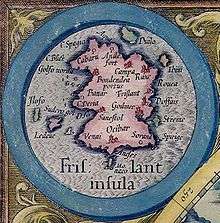Frisland


Frisland, also called Frischlant, Friesland, Frislandia, or Fixland, is a phantom island that appeared on virtually all of the maps of the North Atlantic from the 1560s through the 1660s.
It originally may have referred to Iceland, but after the Zeno map (1558) placed it as an entirely separate island south (or occasionally south-west) of Iceland, it appeared that way on maps for the next 100 years. Its existence was given currency in manuscript maps of the 1560s by the Maggiolo family of Genoa and was accepted by Mercator and Jodocus Hondius. Some early maps by Willem Blaeu, such as his 1617 map of Europe, omit it, but it reappears on his 1630 world map as one of many islands shown off the eastern coast of Labrador which was then believed to extend to within a few hundred miles of Scotland. It also appeared on a 1652 world map by Visscher, largely copied from that of Blaeu.
Frisland was shown as a roughly rectangular island with three triangular promontories on its western coast. Its place-names have a very Italian look (Aqua, Spagia, Bondendea, Monaco), a fact which seems to reinforce the suspicion that its details were fabricated in southern Europe.
Frisland eventually came to be identified with the Faroe Islands. However, Frisland and the Faroe Islands both appear on several maps, many hundreds of miles apart.
Frisland appears to be born out of confusion between an imaginary island and the actual southern part of Greenland. Even in the mid-18th century, explorers' maps clearly depicted Frisland as separated from Greenland by a wide strait. The myth of Frisland was exposed as explorers, chiefly from England and France, charted and mapped the north-west waters. However, Frederick J. Pohl identifies Frisland with an island he refers to as "Fer Island", modern English Fair Isle, an island lying between mainland Shetland and the Orkney islands.[1]
References
- ↑ Frederick J. Pohl, Prince Henry Sinclair: His Expedition To The New World In 1398 (London: Davis-Poynter, 1974; and published in America by Clarkson Potter, 1974).
Further reading
- Ramsay, Raymond (1972). No Longer on the Map. New York: Viking Press. pp. 53–76. ISBN 0-670-51433-0.